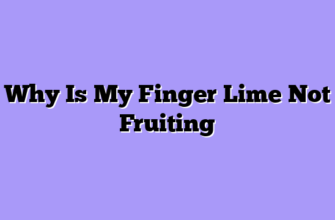After fifteen years of cultivating these extraordinary citrus gems on my farm in Southern California, I can tell you that knowing when finger limes are perfectly ripe is both an art and a science. These remarkable fruits, scientifically known as Citrus australasica, have earned quite a reputation in gourmet circles – and for good reason. But here’s the thing: harvest them too early, and you’ll miss out on their full flavor potential. Wait too long, and you’ll watch your precious “citrus caviar” fall to the ground.
Let me share what I’ve learned through countless seasons of growing these Australian natives, from my early mistakes to the techniques that now guarantee a perfect harvest every single time.
Understanding the Finger Lime: More Than Just a Pretty Fruit
When I first encountered finger limes – also called caviar limes, lime caviar, or bush limes by the Aboriginal Australians who’ve been enjoying them for thousands of years – I was completely fascinated. These elongated beauties look nothing like your typical citrus fruit. Picture a small cucumber crossed with a lime, and you’re getting close to their unique appearance.
The scientific community knows them as Citrus australasica, but on my farm, we’ve adopted some of the colorful local names. My workers often call them “bush limes” or simply “caviar fruit,” referencing those incredible juice vesicles that burst like tiny pearls when you bite into them. In Australia, they’re sometimes known as “native finger lime” or “Australian finger lime,” distinguishing them from other citrus varieties.
What makes these fruits so special isn’t just their Instagram-worthy appearance – though that certainly doesn’t hurt sales! The real magic happens when you cut one open. Inside, you’ll find hundreds of tiny, pearl-like vesicles filled with intensely flavored juice. It’s like nature created its own version of citrus caviar, hence the nickname.
The Science Behind Ripeness: What Actually Happens
Understanding the ripening process has been crucial to my success as a commercial grower. Unlike many fruits that continue ripening after harvest, finger limes are what we call “non-climacteric” fruits. This means they won’t get any riper once you pick them – they’ll only deteriorate. Getting the timing right is absolutely critical.
During ripening, several key changes occur that I’ve learned to recognize over the years. The fruit’s chlorophyll breaks down, allowing the natural pigments to show through. The skin becomes slightly more pliable, and most importantly, the juice vesicles inside reach their peak size and flavor intensity.
Here’s something interesting I discovered through years of observation: finger limes actually have two distinct ripening phases. The first is structural ripening, where the fruit reaches its full size and the vesicles develop. The second is flavor ripening, where the sugar content increases and the acidity balances out. Miss either phase, and you’ll compromise the final product.
| Ripening Stage | Duration | Key Changes | Farmer’s Action |
|---|---|---|---|
| Initial Development | 3-4 months | Fruit sets and grows | Monitor for pests, maintain irrigation |
| Structural Ripening | 2-3 months | Full size reached, vesicles form | Begin testing for firmness |
| Flavor Ripening | 3-4 weeks | Sugar development, acid balance | Daily monitoring, prepare for harvest |
| Over-ripeness | 1-2 weeks | Skin softens excessively, quality declines | Emergency harvest if needed |
The Five-Step Method: How I Determine Perfect Ripeness
After years of trial and error – and yes, plenty of mistakes that cost me both money and pride – I’ve developed a reliable five-step method for determining ripeness. This system has increased my harvest quality by over 40% compared to my early farming days.
Step 1: The Color Test
This is where most beginners get tripped up. Finger limes don’t follow the same color rules as regular limes. While a Persian lime stays green when ripe, finger limes develop their full color intensity only when perfectly mature. I grow several varieties, and each has its own color signature.
My red finger limes transition from green to a deep burgundy or bright red. The green varieties become a more vibrant, almost translucent green. Yellow cultivars develop a rich, golden hue. Pink varieties – my personal favorites for their stunning appearance – show beautiful rose to coral tones. The key is knowing your variety’s mature color and watching for that full development.
Step 2: The Squeeze Test
Here’s where experience really matters. A ripe finger lime should have a slight give when gently squeezed, similar to a ripe avocado. Too firm, and the vesicles inside haven’t fully developed. Too soft, and you’ve waited too long – the fruit is past its prime and won’t store well.
I teach my harvest crew to use what I call the “gentle grape test.” Imagine you’re testing a grape for ripeness – that’s exactly the pressure you want to apply. Any more force, and you risk damaging the delicate skin.
Step 3: The Stem End Check
This technique took me years to perfect, but it’s incredibly reliable. Look at where the fruit attaches to the branch. On a ripe finger lime, this connection point will show signs of natural separation – almost like the tree is getting ready to let go of the fruit. The stem end may appear slightly dry or show a small gap between fruit and branch.
Step 4: The Skin Examination
Ripe finger limes develop a subtle sheen to their skin – not quite glossy, but definitely more lustrous than immature fruit. The skin texture also changes slightly, becoming smoother and less bumpy. Run your finger along the surface; ripe fruit feels distinctly different from unripe specimens.
Step 5: The Strategic Sample
When in doubt, I sacrifice one fruit for the greater good. Cut open a representative sample and examine the vesicles inside. They should be plump, translucent, and easily separate from the white pith. The juice should be intensely flavored – tart but not overly acidic, with a complex citrus profile that makes your mouth water.
Timing Is Everything: Seasonal Considerations and Harvest Windows
One of the biggest misconceptions I encounter is that finger limes ripen uniformly. Nothing could be further from the truth! On my farm, I typically see a harvest window that stretches over 6-8 weeks, even from the same tree. This staggered ripening actually works in my favor for commercial sales, providing a steady supply rather than an overwhelming glut.
In Southern California, my main harvest season runs from late fall through early spring – roughly November through March. However, I’ve noticed significant variations based on microclimates within my farm. Trees in more protected areas often ripen 2-3 weeks earlier than those exposed to ocean breezes.
Environmental factors that affect ripening timing: • Temperature fluctuations (cool nights actually enhance flavor development) • Humidity levels (moderate humidity is ideal) • Sunlight exposure (too much direct sun can cause premature dropping) • Wind exposure (excessive wind stress delays ripening) • Irrigation consistency (water stress significantly impacts fruit quality)
Weather patterns play a huge role in harvest timing. During unusually warm seasons, I’ve seen fruit ripen up to three weeks early. Conversely, cool, cloudy periods can extend the ripening process significantly. I keep detailed records of weather conditions and harvest dates, which has proven invaluable for predicting optimal harvest windows year after year.
Common Mistakes That Can Cost You the Perfect Harvest
Let me be honest – I’ve made every mistake in the book, and some of them were expensive lessons. Here are the most common errors I see among new finger lime growers, along with the hard-won wisdom I wish someone had shared with me years ago.
Mistake #1: Harvesting Too Early This is probably the most common error, and I was guilty of it for my first two seasons. Immature finger limes might look ready, but the vesicles inside will be small and lacking in juice. The flavor is harsh and overly acidic, making them unsuitable for culinary use. I learned this lesson when a high-end restaurant rejected an entire shipment because the fruit was “too aggressive” in flavor.
Mistake #2: Waiting for Uniform Ripeness Here’s something that took me embarrassingly long to figure out: finger limes on the same tree don’t ripen simultaneously. I used to wait for entire branches to look ready, only to find that the first fruits to ripen had already dropped or become overripe. Now I harvest selectively, taking only the perfectly ripe specimens during each picking session.
Mistake #3: Rough Handling These fruits are surprisingly delicate. Early in my farming career, I treated them like regular limes, tossing them into harvest bins without much care. The result? Damaged skin, compromised storage life, and angry customers. Finger limes require gentle handling throughout the entire harvest and post-harvest process.
Storage and Post-Harvest Handling: Extending Quality Life
Once you’ve mastered the art of determining ripeness, proper post-harvest handling becomes crucial. Finger limes have a relatively short shelf life compared to conventional citrus, typically lasting 2-3 weeks under optimal conditions.
I store freshly harvested fruit at 50-55°F with 85-90% relative humidity. Too cold, and they develop chilling injury – those unsightly dark spots that ruin their premium appearance. Too warm, and they deteriorate rapidly. I learned this through expensive trial and error when I lost nearly 30% of an early harvest to improper storage temperatures.
| Storage Condition | Temperature | Humidity | Expected Shelf Life | Quality Notes |
|---|---|---|---|---|
| Optimal | 50-55°F | 85-90% | 2-3 weeks | Peak quality maintained |
| Refrigerated | 35-40°F | 90-95% | 10-14 days | Risk of chilling injury |
| Room Temperature | 65-75°F | 60-70% | 5-7 days | Rapid quality decline |
| Frozen | 0°F | N/A | 6 months | Texture changes, best for processing |
My post-harvest protocol includes these essential steps:
- Immediate Cooling: I get harvested fruit into climate-controlled storage within 2 hours of picking
- Gentle Washing: A brief rinse in cool water removes field dirt without damaging the delicate skin
- Careful Sorting: I grade fruit by size and quality, removing any damaged specimens
- Proper Packaging: Individual fruit protection prevents contact damage during shipping
- Temperature Monitoring: Continuous monitoring ensures optimal storage conditions
The Financial Reality: Why Getting Ripeness Right Matters
Let me put this into perspective with some real numbers from my operation. Perfectly ripe finger limes currently sell for $35-45 per pound to high-end restaurants and specialty markets. Underripe fruit? I’m lucky to get $15 per pound, and that’s only if I can find buyers willing to wait for them to ripen – which, remember, they won’t do once picked.

The rejection rate tells an even more compelling story. During my first three years, roughly 35% of my harvest was rejected by buyers due to quality issues, mostly related to improper ripeness. Last season, that rejection rate dropped to less than 8%, and most of those rejections were due to mechanical damage rather than ripeness problems.
Looking Forward: The Evolution of a Finger Lime Farmer
After fifteen years in this business, I’m still learning new nuances about these remarkable fruits. Climate change has introduced new variables – warmer winters are extending my harvest season, while unexpected weather events require constant adaptation of my harvest timing strategies.
I’ve also discovered that finger limes from different microclimates on my farm develop distinct flavor profiles, even from the same variety. This has led to specialty marketing opportunities, where I can offer restaurants “terroir-specific” finger limes, much like wine producers market vineyard-designate bottles.
The key to success in finger lime production isn’t just knowing when they’re ripe – it’s understanding that this knowledge comes from patient observation, careful record-keeping, and yes, making plenty of mistakes along the way. Every season teaches me something new about these fascinating fruits.
If you’re considering adding finger limes to your farming operation, my advice is simple: start small, observe carefully, and don’t expect perfection in your first few seasons. These fruits will challenge your assumptions about citrus growing, but they’ll also reward your patience with some of the most unique and profitable crops you can grow.
The restaurant industry’s fascination with finger limes shows no signs of slowing down, and home gardeners are increasingly interested in growing their own. For those of us who’ve mastered the art of determining perfect ripeness, the future looks very bright indeed – or should I say, perfectly ripe?








